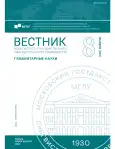VAGUE REFERENCE IN SPEECH AND GESTURE: L2 VS L1
- 作者: Kiose M.I.1,2, Zyryanova A.I.1, Karkhut M.V.1, Kuznetsov B.A.1, Novoselova D.M.1, Shumansky F.A.1
-
隶属关系:
- Moscow State Linguistic University
- Institute of Linguistics RAS
- 期: 编号 8(889) (2024)
- 页面: 76-84
- 栏目: Linguistics
- URL: https://bakhtiniada.ru/2542-2197/article/view/298483
- ID: 298483
如何引用文章
全文:
详细
The study explores the notion construal in speech and in gesture in expository monologues in the second language (English) contrasted with the native language (Russian). The results display similar distribution in vague reference in speech and in gesture, which overall evidence in favour of common discourse patterns of multimodal construal. However, the prevalence of placeholders aligned with representational gestures in the second language attests to the higher role of lexical search to construe vague notions aided with the use of gestures.
作者简介
Maria Kiose
Moscow State Linguistic University; Institute of Linguistics RAS
编辑信件的主要联系方式.
Email: maria_kiose@mail.ru
Doctor of Philology, Assistant Professor, Chief Researcher at Centre for Sociocognitive discourse studies at Moscow State Linguistic University, Leading Researcher at Laboratory of Multichannel communication at Institute of Linguistics RAS
俄罗斯联邦Alena Zyryanova
Moscow State Linguistic University
Email: zyranova@list.ru
Volunteer of the Centre for Sociocognitive Discourse Studies, Student of the Faculty of Translation and Interpreting Moscow State Linguistic University
俄罗斯联邦Maria Karkhut
Moscow State Linguistic University
Email: mariakarkhut@mail.ru
Volunteer of the Centre for Sociocognitive Discourse Studies, Student of the Faculty of Translation and Interpreting Moscow State Linguistic University
俄罗斯联邦Boris Kuznetsov
Moscow State Linguistic University
Email: b04kuznetsov@gmail.com
Volunteer of the Centre for Sociocognitive Discourse Studies, Student of the Faculty of Translation and Interpreting Moscow State Linguistic University
俄罗斯联邦Daria Novoselova
Moscow State Linguistic University
Email: dasha.novoselova.2004@mail.ru
Volunteer of the Centre for Sociocognitive Discourse Studies, Student of the Faculty of Translation and Interpreting Moscow State Linguistic University
俄罗斯联邦Fedor Shumansky
Moscow State Linguistic University
Email: fedor.shumanskiy@mail.ru
Volunteer of the Centre for Sociocognitive Discourse Studies, Student of the Faculty of Translation and Interpreting Moscow State Linguistic University
俄罗斯联邦参考
- Podlesskaya, V. I. (2013). Vague names in Russian speech: a corpus study. Computational Linguistics and Intellectual Technologies, 12(19), 631–643. (In Russ.)
- Channell, J. (1983). Vague language: Some vague expressions in English. Dr. Philosophy Thesis. York: University of York.
- Iriskhanova, O. K. et al. (2023). Vague reference in expository discourse: multimodal regularities of speech and gesture. Computational Linguistics and Intellectual Technologies, 22, 172–180.
- Gullberg, M. (2008). Gestures and second language acquisition. Handbook of Cognitive Linguistics and Second Language Acquisition (pp. 276–305). Ed. by P. Robinson, N. C. Ellis. NY: Routledge.
- Gregersen, T., Olivares-Cuhat, G., & Storm, J. (2009). An examination of L1 and L2 gesture use: What role does proficiency play? Modern Language Journal, 93(2), 195–208.
- Lin, Y. L. (2019). Speech-accompanying gestures in L1 and L2 conversational interaction by speakers of different proficiency levels. International Review of Applied Linguistics in Language Teaching, 60, 123–142.
- Negueruela, E., Lantolf, J. P., Jordan, S. R., & Gelabert, J. (2004). The “private function” of gesture in second language speaking activity: A study of motion verbs and gesturing in English and Spanish. International Journal of Applied Linguistics (United Kingdom), 14(1), 113–147. (In Russ.)
- Stam, G. (2006). Thinking for speaking about motion: L1 and L2 speech and gesture. International Review of Applied Linguistics in Language Teaching, 44(2), 145–171.
- Lieber, R. (2016). English nouns: The ecology of nominalization. Cambridge: Cambridge University Press.
- Malakhova, V. L. (2022). Explanation as a type of pragmasemantic relations in English discourse system. Vestnik of Moscow State Linguistic University. Humanities, 1(856), 65–71.
- Alibali, M. W. et al. (2017). Representational gestures help speakers package information for speaking. Why gesture? How the hands function in speaking, thinking, communicating (pp. 15–38). Ed. by R. B. Church, M. W. Alibali, S. D. Kelly. Amsterdam: John Benjamin.
- Nagpal, J., Nicoladis, E., & Marentette, P. (2011). Predicting individual differences in L2 speakers’ gestures. International Journal of Bilingualism, 15(2), 205–214.
- Hadar, U., Dar, R., & Teitelman, A. (2001). Gesture during speech in first and second language: Implications for lexical retrieval. Gesture, 1(2), 151–165.
- Goldin-Meadow, S. (2003). Hearing gesture: How our hands help us think. Cambridge, MA: The Belknap Press.
补充文件










